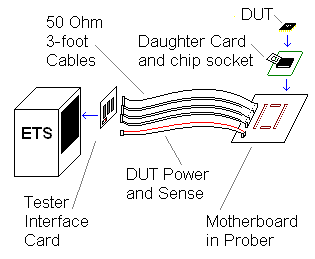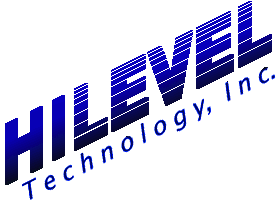|
One popular use of HILEVEL testers involves exercising the DUT while
on a probe station, especially in Failure Analysis labs. Although direct
docking is possible with a manipulator, the cost of such an arrangement
can be enough of an obstacle to give prober cabling a compelling attraction.
Here are some important considerations:
Cables
The length and quality of your cabling is extremely important, especially at speeds above 1 or 2 MHz. Use of poor quality cables (ordinary ribbon or other unshielded cables with mismatched impedance) can make even the most expensive testers perform poorly. Use 50 Ohm coax or a shielded ribbon cable at 50 Ohms with ground lines between each signal line.
Excessive cable length can introduce problems that are difficult to find. Each foot of cable adds about one and one-half ns to the data path, both for the tester and the DUT. Be sure to allow for this in your timing assignments, and sometimes within your translation or simulation; if compares or other edges are near the end of the cycle, you may have enough “turn-around” delay that vectors must be skewed so that the compares can be done early in the next cycle. Keep your cables as short as possible. In our illustration we show 3-foot cables, which should be considered a maximum length. This method is called “soft docking” and is the lowest in cost, but the environment is not very “clean” at faster test rates. Hard docking (also called “direct docking”) is the best for signal integrity, but tester fan vibration can be transferred to the prober and can be difficult to manage, and the manipulators are expensive. The most cost effective approach is something we call “firm docking”. By using a low-cost manipulator and positioning the test head close to the probe site, very short cables and be used while isolating the prober from vibration.
Power and Ground
We do not recommend bringing DUT power and ground to the prober by
way of the same ribbon cables carrying signals, but rather to run separate
leads for them. If you plan to do any Iddq measurements you must also bring
up the sense lines; on the DUT board the sense is identified by "S+"
and "S-" next to the DUT supply pads. Be sure to cut the etch
joining the sense lines to Vdd plus and minus at the DUT board, and do
not reconnect sense to power until "the last possible centimeter"
of connection to the DUT. You will also need .01 and/or .1 uf bypass capacitors
right at the power pins of the DUT chip socket for a local reservoir of
power. Keep the leads as short as possible, and No Electrolytics!
Daughter Card
Your cables will typically connect to some type of motherboard under the
prober, which then receives various daughter cards that route signals and
power to different types of DUTs. We have seen the greatest successes in
this type of arrangement when daughter cards and their interface is built
in such a way that allows them to be connected to fixturing directly on
the front of the ETS tester as well as to the motherboard in the
prober. This allows you to develop your tests without the hazards of remote
cabling slowing you down, and also helps you to diagnose problems introduced
by the prober fixturing if they should occur. When you move your daughter
card to the prober you can see exactly how much effect your fixturing has
on the performance of the DUT. Pay close attention to the spacing between
signal connectors on the front of the ETS and be aware of acreage displacement
needed on your daughter card to fit between these connectors.
|

Typical Prober Interface
DUT Drive and Loading
Knowledge of your chip is a crucial tool for cable interface preparation.
Devices with 20mA of drive current on output pins should have little trouble
with a clean 50 Ohm environment. If your DUT has very low drive capability
it may have difficulty driving back to the tester and overcoming "line
charge".
The phenomenon of line charging is a natural occurence that can play a
frustrating role in your test development. It becomes a factor on bidirectional
data lines when the tester drives logic high for one or more vectors and
then switches direction so that the DUT can drive data back to the ETS.
These data lines will have been "charged" by the ETS driving
the desired logic level through the cables, and even though the ETS drivers
will have been tristated for the direction change, the cables can remain
charged for quite some time - perhaps many microseconds - as the charge
slowly drains off. If your chip or fixturing does not have sufficient loading
to drain this charge, it will appear to the DUT that tester is still driving
when your chip attempts to output data. On the scope, this may look like
signal contention, and it makes good timing measurements impossible.
There are three recommended ways to attack this problem:
1. Avoid the transition area. This means that you must test with
your compare strobes placed well past the "contention" period,
and may force you to run very slow. Timing measurements are not very meaningful
in this approach.
2. Load resistors at the DUT. This can be effective, but messy.
Also you must consider whether or not your DUT can drive the cables after
battling the load resistors. Typically a pull-up/pull-down arrangement
using 1K to 10K resistors is applied, depending on the chip's tolerance
to loads.
3. ETS programmable loads. Probably the easiest and cleanest cure,
these loads allow you to program actual Ioh and Iol current potentials
via software. These active loads are at the tester, so the DUT does not
have to overcome loads before driving the cables. Again, you must consider
the overall drive capability of your DUT. On some ETS systems, the programmable
loads are standard while on others it is an option. Contact HILEVEL for
pricing.
Related info
Q'nApp #L9: Iddq Testing
QL18.zip is a zipped Word file of this
Q'nApp.
Click your browser's Back button to return to the
Q'nApps
index.
|


#L18